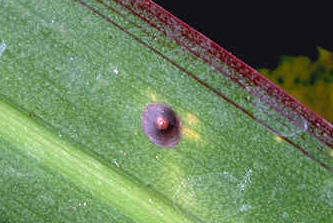Description:
Comma Scale, Oyster Shell Scale,
Eulecanium
Scale and Mealy Scale.

Detection:
Check on the underside of your leaves and
on the stem of the plant for
oval, shell
or scale covered insects. They
vary in color
from white to greenish brown.
A severe infestation
will have the appearance of lumpy
blisters
on the underside of the leaves
and on the
stem; this will eventually result
in the
yellowing of affected leaves
or fronds and
they will drop off. They also
excrete a sticky
honeydew which could attract
a black sooty
mold.
Control:
a) If small number of plants are affected;
Gently remove the scales from the leaves,
fronds or stem with a small soft
brush, (for
tough plants an old toothbrush
will suffice)
then rinse the plant with clear
tepid water
containing a little liquid soap
(approximately
half a teaspoon per gallon) do
not use a
soap that contains a detergent.
For heavy
infestations, take the plant
into a well
ventilated area, preferably outside
and spray
the plant with malathion or equivalent.
When
the spray has dried, rinse the
plant with
clear tepid water. Repeated applications
may be necessary so check regularly
for any
signs of re-infestation. You
can also a cotton
swab dipped in alcohol or use
a systemic
insecticide.
b) If large number of plants is affected:
OPTION 1:Non Chemical management:
-
- In minor infestations, it may be possible
to hand-wipe branches to reduce
numbers of
scales.
- Natural enemies such as ladybird beetles
and parasitic wasps may help
control scale
populations. Avoid use of broad-spectrum
insecticides which kill these
beneficial
insects.
- Provide proper culture. Healthy plants are
more able to tolerate damage.
- Prune out and destroy isolated infestations
and heavily infested branches, when practical.
OPTION 2: Chemical management:
Scout for crawlers and gather life history
data. Oils are effective in very
early spring
in controlling lecanium, san
jose, and brown
scales, but not oystershell scale.
All products
excluding oils apply to control
at the immature
crawler stage, usually in late
spring to
early summer.
- Ace Hardware Diazinon Insect Spray
- Ace Hardware Dursban Insect Spray
- Black Leaf 25% Diazinon
- Black Leaf Dursban
- Lilly Miller Diazinon Insect Spray
- Lilly Miller Malathion Insect Spray
- Ortho Diazinon Ultra Insect Spray
- Ortho Volck Oil Spray
- Spectracide Diazinon Multi-Purpose Insect
Spray Concentrate
- This list may not include all products registered
for this use
Active ingredient table for the above listed
products:
| Product |
Active Ingredient |
EPA |
| Ace Hardware Diazinon Insect Spray |
diazinon |
8845-92-9688 |
| Ace Hardware Dursban Insect Spray |
chlorpyrifos |
33955-547-9688 |
| Black Leaf 25% Diazinon |
diazinon |
5887-132 |
| Black Leaf Dursban |
chlorpyrifos |
5887-144 |
| Lilly Miller Diazinon Insect Spray |
diazinon |
802-444 |
| Lilly Miller Malathion Insect Spray |
malathion |
802-123 |
| Ortho Diazinon Ultra Insect Spray |
diazinon |
239-2643 |
| Ortho Volck Oil Spray |
petroleum oil |
239-16 |
| Spectracide Diazinon Multi-Purpose Insect
Spray Concentrate |
diazinon |
8845-92 |
|

